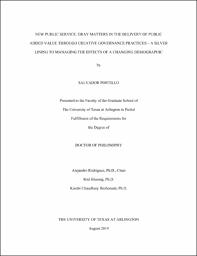| dc.description.abstract | The baby boomer generation, those people born worldwide between 1946 and 1964 are now making their mass exodus from the workforce and are on the imminent road to retirement. Or maybe they are not. The road to retirement is shrouded in uncertainty for countless older Americans. The financial crisis in 2008 left many reeling with debts and inadequate payments from their hard earned pensions. In addition to this, research has shown poor planning has left a significant portion of baby boomers facing financial insecurity, requiring them to work longer than anticipated. Nevertheless, large swaths of older adults are having difficulty finding work and are discouraged by their job prospects. A considerable number of boomers would contend they are more than just big box store greeters or free labor. That said, institutional and cultural ageism and discrimination continue to penetrate work and social settings, with perceptions of seniors representing decline and disability (Milken Institute, 2017). As research has shown, this is far from reality. According to a 2009 Pew Research survey, baby boomers (those ages 65 to 74) say they feel 10 to 19 years younger than his or her chronological age, and one-in-six say they feel at least 20 years younger than their actual age (Parker and Cohn, 2009).
Although the societal problem of population aging is well known, there has not been extensive research on aging by public administration scholars in the United States. To date, public administrators, policymakers, and program decision makers have paid little attention to creative ideas that plan for, generate public support for, and pay for social and economic programs through innovative finance techniques that could provide a direct benefit to the demographically diverse aging population. Concomitantly, delivering an indirect benefit to society where desired social outcomes are achieved. More specifically, creative governance innovation through strong cross-sector collaborations and age-friendly public policy measures is needed to improve the economic and social well-being of older Americans experiencing financial insecurity in older age. This suggests the promotion of suitable employment opportunities within collaborative networks that could increase disposable income for seniors. It also implies city practices take their senior population into account when crafting public policy, strategic plans, and programs; local planning; narrowing the digital divide; or creating novel ideas to achieve desired social outcomes. These measures have the potential of improving the quality of life for seniors, delivering economic impetus for the local economy, and boosting the tax base while at the same time lessening the budget strain on entitlement programs. Public administrators would do well to recognize the silver lining to managing the effects of a changing demographic and the economic and social value that older Americans bring to local government.
This study develops a Public Added Value Index (PAVI), which is comprised of three dimensions essential for assessing and measuring the extent to which local public agencies in Texas create public added value for older Americans and society as a whole. Equally, each of the following dimensions is a hypothesis in the study: transformational leadership; trust and legitimacy, and; information and communications technologies (ICT) and e-government. These three dimensions of public added value could be generalized across most or all types of contemporary public organizations in the state of Texas. Moreover, the dimensions may enhance the themes of public value measurement, and recognize and account for the creation of public added value in contemporary public administration. This study also assumes the creation of public added value at the local government level is evaluated against these three dimensions. The results of this study could inform public policy and program decisions of public administrators. Also, these findings should interest public managers, policymakers, practitioners, and academic scholars. Data were collected from 43 cities across different geographical locations in the state of Texas. The results support two hypotheses (dimensions 1 and 3) and the third hypothesis is supported when dimension 2 is run independently in conjunction with controlling variables in multiple linear regression analysis. The findings suggest public added value is created at the local government level. Theoretical and practical implications are discussed. | |


